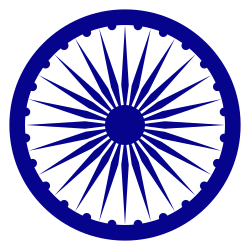Symbolic history
When Gautama Buddha achieved enlightenment at Bodh Gaya, he came to Sarnath. There, he found his five disciples, Assaji, Mahānāman, Kondañña, Bhaddiya and Vappa, who had earlier abandoned him. He introduced his first teachings to them, thereby establishing the Dharmachakra. This is the motif taken up by Ashoka and portrayed on top of his pillars.
The 24 spokes represent the 24 Jain Tirthankara of the present cosmic cycle. Alternatively, the 24 spokes represent the twelve causal links taught by the Buddha and paṭiccasamuppāda (Dependent Origination, Conditional Arising) in forward and then reverse order. [2] The first 12 spokes represent 12 stages of suffering. The next 12 spokes represent no cause no effect. So, due to awareness of the mind, the formation of mental conditioning stops. This process stops the process of birth and death, i.e., nibbāna. It also depicts the “wheel of time”. The twelve causal links, paired with their corresponding symbols, are:
- Avidyā ignorance
- Saṅkhāra conditioning of mind unknowingly
- Vijñāna not being conscious
- Nāmarūpa name and form (constituent elements of mental and physical existence)
- Ṣalāyatana six senses (eye, ear, nose, tongue, body, and mind)
- Sparśa contact
- Vedanā sensation
- Taṇhā thirst
- Upādāna grasping [3]
- Bhava coming to be
- Jāti birth
- Jarāmaraṇa old age [4] and death [5] – corpse being carried.
These 12 in forward and reverse represent a total 24 spokes representing the dharma. The Ashoka Chakra depicts the 24 principles that should be present in a human.
This page is based on this
Wikipedia article Text is available under the
CC BY-SA 4.0 license; additional terms may apply.
Images, videos and audio are available under their respective licenses.


